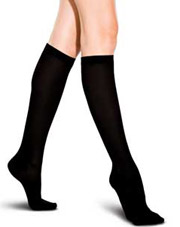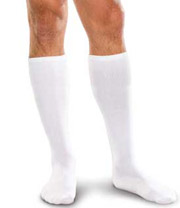Compression Socks
North York Location
 Medical gradient compression socks and stockings improve venous and lymphatic blood flow. SIGVARIS stockings are designed to deliver a controlled amount of pressure which is greatest at the ankle of the garment and gradually decreases towards the top of the stocking. This gradient promotes better venous blood flow which in turn helps to relieve and control edema (swelling), varicose veins, leg fatigue and other problematic leg conditions.
Medical gradient compression socks and stockings improve venous and lymphatic blood flow. SIGVARIS stockings are designed to deliver a controlled amount of pressure which is greatest at the ankle of the garment and gradually decreases towards the top of the stocking. This gradient promotes better venous blood flow which in turn helps to relieve and control edema (swelling), varicose veins, leg fatigue and other problematic leg conditions.
Venous Problems: Are you at risk?
If you are at risk for venous problems, you are a candidate for compression socks or stocking therapy and vascular disease prevention. You may be at risk if you can answer “yes” to two or more of the following questions/statements:
- Age over 40
- Family History
- Pregnancy / Hormonal Therapy
- Excess Weight / Obesity
- Inactivity / Sedentary Lifestyle
- Smoking
- Diabetes
- Limb Trauma
- Long Distance Travel
- Sclerotherapy
Healthy Leg Questionnaire
- I sit or stand for prolonged periods of time.
- I have spider veins on my legs
- I am over 40 years of age
- I have an excess of weight
- Varicose veins runs in my family
- I have varicose veins
- I have had a leg ulcer
- I am pregnant
- My ankles are swollen during the day and in the evening
- I have alterations and some discoloration on the skin of my legs
- I take hormonal treatment (birth control, menopause)
- I have had a blood clot (DVT – Deep Vein Thrombosis)
- I have had a thrombophlebitis (vein inflammation)
If you can answer “yes” to 2 or more of these questions, You are a candidate for compression sock or stocking therapy and Vascular Disease Prevention.
Who Would Benefit From Compression Socks or Stockings?
People who have or are experiencing any of the following conditions can benefit from wearing gradient compression socks or stockings:
- Pregnancy
- Tired, aching, fatigued legs
- Swollen feet, ankles, and legs
- Mild to moderate swelling
- Stand or sit for long periods
- Overweight
Additionally, many people without preceding conditions simply love wearing our gradient compression socks and stockings. Most people love the way they make their legs feel. Conditions that can benefit from wearing gradient compression hosiery.

How do Compression Socks and Stockings Help?
True Gradient compression socks and stockings improve blood flow. Therafirm compression stockings are designed to deliver a controlled amount of pressure which is greatest at the distal end (ankle) of the garment and gradually decreases towards the proximal end (top) of the stocking. This gradient pressure promotes better circulation to help control swelling and relieve tired achy legs. This motion helps to drive blood back to the heart, reduce swelling in the feet and prevent blood clot formation.
Will Insurance Cover my Compression Socks or Stockings?
Most insurance companies, through your Extended Health Benefits Coverage, will reimburse for medical compression sock and stocking expenses. A prescription must first be obtained from your doctor, in order to submit the cost of the compression therapy to your extended health benefits provider.
Our staff in our North York office can assist you with obtaining a prescription, medical coverage details and filling out detailed extended health claim forms. Dr. Shin can assess whether gradient compression socks or stockings are right for you. If so, he will recommend the best product for your needs!
Conditions Compression Socks May Help
During the first trimester of pregnancy relaxation of the veins occur. Your total blood volume may increase as much as 45% in comparison to your non-pregnant level. The relaxation of the vein walls, in areas of venous valves may cause the valve to become incompetent – therefore allowing backward flow of the venous blood. The reduced flow results in venous congestion, which in turn causes swelling and leg discomfort. Ankle swelling occurs most commonly in pregnant women.
During the third trimester of pregnancy the weight of the baby and the uterus may impede return of blood through the veins of your legs. Gradient compression socks and stockings reduce venous congestion, support the superficial veins of your legs, manage the increased blood volume and relaxed vein walls; reducing the amount of swelling and the severity of varicose veins.
- Standing and sitting for long periods of time – Blood pools at the ankles and has a hard time returning to the heart.
- Swollen Feet, Ankles and Legs – Leg swelling generally occurs with an abnormal accumulation of fluid in the tissues of the lower extremity. The medical term for leg swelling from excessive fluid in the tissues is edema. Symptoms of edema include:
- Enlarged ankles and calf (lower leg may appear puffy)
- Decreased mobility (leg may feel heavy)
- Decreased skin elasticity
- Discomfort or tired legs
Varicose Veins and Spider Veins
As you age, the valves can malfunction, and the veins may stretch. Blood can stagnate, causing the veins to dilate. Heredity and hormonal changes during pregnancy and diabetes, and standing or sitting for long periods of time also can influence the development of varicose veins.
You should avoid the standing or sitting for long periods or prolonged inactivity. Advanced cases of varicose veins can result in blood clots, inflammation of the veins, or ulcers. Larger varicose veins may require surgery. Signs that medical attention is needed include muscle cramps, fatigue or swelling in the legs, excessive tenderness or any indication of an ulcer. Three easy actions can help you maintain the health of your leg veins:
- Exercise
- Wearing gradient compression socks or stockings
- Elevation
Regular walking, swimming or cycling works the calf and thigh muscles. Contraction of these muscles helps the return of venous blood from the legs back to the heart. Wearing gradient compression socks and stockings won’t eliminate varicose veins, but they can help alleviate the symptoms caused by the veins, such as aching, heaviness, and swelling. It can also prevent worsening of the veins.
Chronic Venous Insufficiency (CVI)
- swelling in legs and/or ankles
- tight feeling calves
- itchy painful legs
- pain during walking that stops with rest
- brown-colored skin, particularly near the ankles
- varicose veins
- leg ulcers
Feel Better Today
Are Compression Socks or Stockings Right for You? Contact our office to schedule a consultation with to find out!
CONTACT US »

